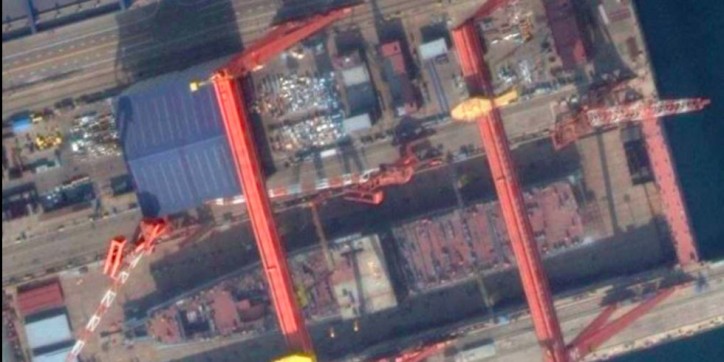China's Defense Ministry confirmed that China's second aircraft carrier is under construction. The state-run newspaper Xinhua stated that the aircraft carrier is China's first to be built "completely on its own," without using a foreign-made hull or extensive foreign assistance.

The photo above is a satellite image taken of the carrier under construction in Dalian, China. The carrier hull is being constructed in two pieces.
The image below shows the progress on the construction of the suspected Chinese aircraft carrier since May 2015:

The carrier, alternately known in Chinese defense-watching circles as CV-17 (China's first carrier, Liaoning, is CV-16) or Type 001A will have a displacement of 50,000 tons and "will be a base for J-15 ('Flying Shark') and other types of aircraft," a Defense Ministry spokesman said.
The new carrier will likely have an air wing of approximately 40+ aircraft, including helicopters.
Like the Liaoning, the new carrier will use a "ski jump" to get aircraft into the air, essentially a large ramp placed at one end of the aircraft carrier to shoot planes in the sky. While ski jumps designs allow for heavier payloads on planes launched from a flat deck, they are unable to to match the muscle of the catapult design used by nearly all American aircraft carriers—which is why China is known to be working on an electromagnetic system (similar to the American EMALS) to launch planes. Still, their continued use of a ski jump suggests it has not yet perfected the technology.
That one carrier is under construction—and not two—suggests China is not satisfied with the ski jump method. China is believed to have been given access to steam catapult technology via Brazil's aircraft carrier, but they seem willing wait for for the higher-tech solution of a electromagnetic catapults. China appears content to slowly build out its ability to project power on the ocean, without rushing carriers out to sea.
Still, with two active aircraft carriers, China would join an elite club—only India and Italy have two active aircraft carriers, while the U.S. has at least ten.
China's first carrier, the Liaoning was purchased as a hull from Ukraine for approximately $20 million and was refitted at the CSIC Dalian Shipyard.
The previous year, 2015, was marked by heightened tensions between China on one side, and the USA and other countries on the South China Sea, Japan, the Philippines and Taiwan on the other side. After the U.S. Navy’s guided missile destroyer USS Lassen sailed within 12 nautical miles off Zhubi Reef of the Nansha Islands on October 27, Chinese military officials even threatened with war if such patrols were to happen again.
China claims almost all of the South China Sea and has lately been building a net of artificial islands in contested parts of the sea. The United States claim that these islands would allow the Chinese to control one of the world’s most important energy trade routes, as EIA, the U.S. Energy Information Administration, put it.
Source: www.popularmechanics.com